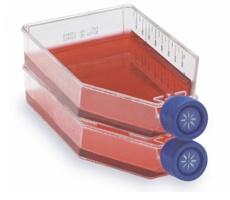When your research project depends on delicate little organisms known as “cells,” day-to-day life in the lab is always a bit different. Regardless, my days usually begin the same way: I come into lab in the morning, vaguely sticky from my bike ride there in the humid morning sun, and dump my backpack in my mentor’s office. I grab my lab notebook and head into lab, where I pull on my gloves and start removing bottles of media (basically just a solution that provides a nice, utopian environment for cells) and any other solutions I might need for experiments or procedures that day out of the 4° (aka the refrigerator) and place them in a water bath to bring them to room temperature. Then I check on my cell cultures. Cells are basically fragile, very boring pets that cling to the bottom of a culture flask, happily growing into a single layer, and they have to be looked after for optimum health.

source: Thermo Fisher Scientific
When they’ve almost completely covered the bottom of the flask (that is, reached “confluency”), they are ready for use in experiments. Or, they must be “split” — collected and divided amongst multiple new flasks — so they can continue proliferating. However, sometimes they don’t behave as you want. If it’s a bad day, you walk into the lab, excited to get started on your experiment. You open the incubator, obtain your flask of cells presumably bathing happily in their bright pink media, and check them under the microscope only to see — what! — the cells have detached from the bottom of the flask and are drifting languidly, a guarantee that they are quite dead and possibly contaminated. Sadly casting away any thoughts of advancing science even one timid step forward, you bleach your cells and send them down the drain, along with all of the other fluids you used to prepare them since you’ll never know exactly where the contamination originated. Then you have to make new media and prepare a new flask of cells from your frozen stock, and then there’s nothing to do but wait until the next day when your previously frozen cells have readjusted to their new life in the warm belly of the incubator. If it’s a good day, your cells are alive and ready for whatever experimental abuse you throw their way. If it’s a really good day, you’re able to put in a full day’s worth of work, and the experiment you’ve been working on for the past few days works out and you get beautiful, tangible, blessed results. Most days are usually just good days.
Once my reagents have come to room temperature, I spray down the hood where all work that requires a sterile environment takes place with 70% ethanol and wipe it down. Then I remove all of my stuff from the water bath and attack them with healthy squirts of ethanol. (Once you’ve had your cells get contaminated, you will never take disinfecting your bottles of solutions lightly ever again.) Then I wipe them down with paper towels and place them in the hood. Now I can finally remove my flask or plate of cells from the incubator and get to work. A lot of times, if I’m doing an experiment rather than just cell culture upkeep, this involves pipetting various treatment solutions onto cells on plates, and then putting them back in the incubator to essentially marinate overnight. Other times an experiment may require that cells sit only 10-30 minutes or so as you wait for reactions to occur. Overall, I spend a lot of time waiting for things. This is when I basically just chill in my mentor’s office and read papers or a book. Once my cells have sat for as long as necessary, I can then treat them with a buffer that causes the solution to change color depending on what happened between the cells and treatment. Next I usually run diagnostic tests on them with a plate reader, a cool little machine that hits the wells of cells with a laser and spits out a number for each well that corresponds to the intensity of the color in each well, which can in turn be placed in excel and translated into a nice graph.
If I’m lucky, I go eat lunch with the lab technician, Taylor, at around noon. Sometimes I go earlier, and sometimes much later — it all just depends on what procedures I had to do in the morning. Regardless, it always means a nice 30 minute socialization break at a table outdoors.
After lunch, I sometimes don’t have much else to do. I may have another experiment to run or perhaps one to finish, or I might just have to take care of my cells. If there’s nothing I need to do, I will usually follow Taylor around as she works on various procedures around the lab, and sometimes she will also teach me how to do some of the procedures (Example: I was able to run my first PCR and gel electrophoresis yesterday! Very exciting, I know). If Taylor’s busy, I will hang out in my mentor’s office again until he comes to get me and show me how to do something. Although some days I’ve been able to finish everything before lunch, I am typically able to leave lab at around 4.
And that’s a wrap of a day in the life of this amateur scientist!
